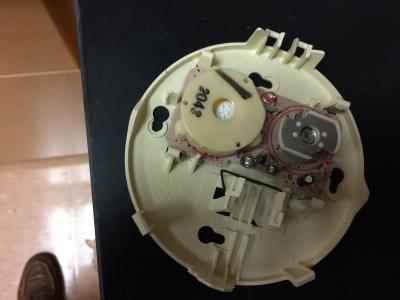Overview:
When radioactive elements decay they emit high-speed particles. These can be detected by use of a cloud chamber. The cloud chamber was invented by Charles Thomson Rees Wilson in 1911. The chamber works by saturating the air inside with alcohol vapor. Cooling the chamber with dry ice supersaturates the air. The energetic particles produced by the radioactive decay ionize some of the air. The ions act as nucleation sites for condensation, leaving a vapor tail which clearly reveals the path of the radiation. Radioactive sources can produce alpha, beta, or gamma radiation. Alpha particles are Helium nuclei, two protons, two neutrons but no electrons. Beta particles are free electrons and have a negative one charge as opposed to the positive two charge of the alpha particles. The mass of an alpha particle is about 7500 times greater than a beta particle. Gamma radiation is made of photons, which are massless and have no charge. All of these properties can be demonstrated in a cloud chamber. Alpha radiation will create wider tracks that will be about 1-2 cm long and easy to see. Longer, thinner tracks are made by beta radiation. Gamma radiation is unlikely to create visible tracks. Charge can be shown by the introduction of a magnet which will cause the paths of the alpha and beta particles to turn but in opposite directions. Students will visualize different types of radiation by observing their effects in a cloud chamber. Cosmic rays like those studied at CosRay and IceCube are one source of radiation. The cloud chamber is an important historical predecessor to these detectors. Also visualizing the tracks is similar to the particle tracks mapped by IceCube. The cloud chamber design is adapted from “Science, Society and America’s Nuclear Waste – Ionizing Radiation” by US Department of Energy, July 1995.
Objectives:
To visually demonstrate radiation and develop an understanding of detectors.
Lesson Preparation:
Building or Making Cloud Chambers: Cloud chamber kits can be ordered from science supply companies. They are inexpensive and easy to construct. (If students are to build them. It is recommended that the instructor build one ahead of time because they can be tricky to get to work the first time.) New models that are cooled by a Peltier device can be ordered which eliminates the need for dry ice, although these are expensive. Plans for building cloud chambers of varying size can also be obtained from the internet. A few good examples are listed in the Resources Section. Those cloud chambers can be prepared in advance by the teacher or small ones can be constructed by students as described below in the Procedure Section (Adapted from “Science, Society and America’s Nuclear Waste – Ionizing Radiation” by US Department of Energy, July 1995.):
Procedure:
You can use a commercially prepared cloud chambers, build one of your own using the directions in the links provided, or have students build one using the procedure below.
DO NOT HANDLE DRY ICE WITH YOUR HANDS. USE TONGS OR GLOVES ONLY TO HANDLE DRY ICE.
Paint the bottom of the container black or cover it with dark construction paper. This will help to see the trails.
Tape blotter paper, cotton, or a sponge to the inside of the container near the top or to the underside of the lid.
Pour a thin layer of ethyl alcohol on the bottom of the container.
Soak the blotter paper, cotton, or a sponge with alcohol.
Place a radiation source in the bottom of the container.
Tightly secure the lid to the container and tape it in place.
Place the container on top of a tray containing dry ice.
Allow the container to cool for approximately 5 minutes.
Darken the room. Shine the flashlight through the side of the container. You should see white condensation trails as lines inside the container (close to the bottom.) They will be easier to see if you look though the top so a transparent lid is preferred.
If you have trouble getting condensation try placing a cup of warm water on the top of the container to warm the saturated sponge.
Note: Commercially produced sources are recommended in addition to Coleman lantern mantle pieces, pieces of fiesta-ware or sources from a smoke detector. These sources are of known activity values and also labeled as alpha, beta, and gamma sources. So students can compare the tracks made by alpha, beta, and gamma sources. Have students observe the vapor trails produced within the cloud chamber and note the different shapes. Have them observer with and without radiation sources to see if they can detect background radiation. Give them different sources and ask them to describe the trails left by different each type of radiation.
Extension:
Provide a magnet to see the effect on the ionization trails. Ask students to reduce/block the different types of radiation with different materials.
Resources:
Link to a cartoon that relates the cloud chamber to cosmic ray showers. http://www.scienceinschool.org/sites/default/files/articleContentImages/14/cloud/issue14cloud6_large.jpg
NASA Cosmic Ray/Cloud Chamber Resource http://crater.unh.edu/pdfs/CosmicRayBook.pdf
West Hill Science Supply to order cloud chamber kits http://www.westhillbio.com/
Plans for different cloud chambers: https://home.cern/students-educators/updates/2015/01/how-make-your-own-cloud-chamber
http://quarknet.fnal.gov/resources/QN_CloudChamberV1_4.pdf
http://makezine.com/projects/cloud-chamber/
https://futurism.com/make-a-cosmic-ray-detector-at-home-and-test-relativity-2/
Instructions are also available in Spanish: http://palmera.pntic.mec.es/~fbarrada/cloud_chamber_spanish.pdf
Assessment:
Students can be assessed by asking them to describe how the cloud chamber works and why the different types of radiation produce different trails. Furthermore they could be assessed by asking them to design a lab to test the effectiveness of different shielding materials on different types of radiation.
Author / Credits:
Cloud chamber design adapted from “Science, Society and America’s Nuclear Waste – Ionising Radiation” by US Department of Energy, July 1995. Lesson by Eric Thuma
Images
 Commercial Cloud Chamber
Commercial Cloud Chamber
 Smoke detector alpha source.
Smoke detector alpha source.Standards
a. Properties of objects and materials b. Understandings about science and technology c. Transfer of energy| Attachment | Size |
|---|---|
| Full Lesson: Cloud Chamber (Download 678.57KB)678.57 KB | 678.57 KB |
